How to capture perfect images of elusive, mischievous red squirrels? Ellie Rothnie shares a few of her best tips and tricks
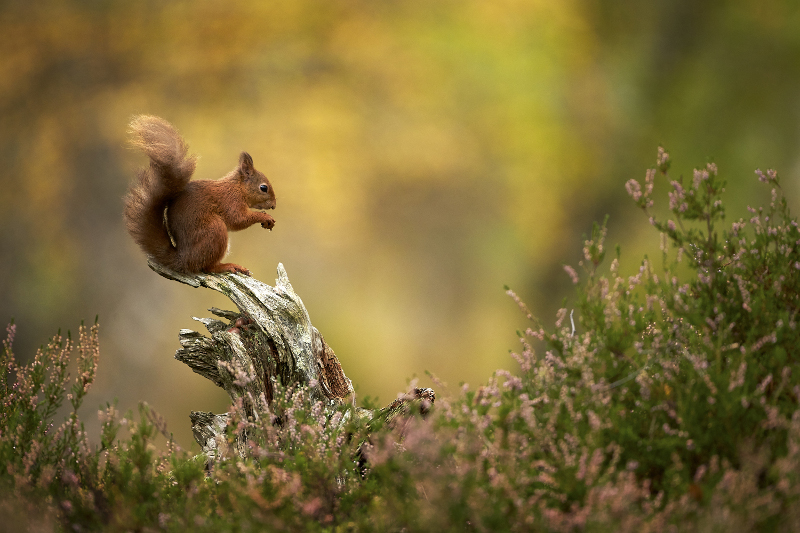
All images by Ellie Rothnie
The red squirrel (Sciurus vulgaris) is one of our best loved UK woodland creatures. Many of us have grown up with books about them, like Beatrix Potter’s Squirrel Nutkin or the red squirrels in The Gruffalo. We were taught how to cross the road safely by one of them – Tufty. There are even beers, wines and whiskies named after them.
This beautiful species was once found across most parts of the UK, however their numbers drastically declined due to the introduction of the eastern grey squirrel (Sciurus carolinensis) from North America. The majority of red squirrels now live north of the border, with Scotland having 75% of the total UK population. There are of course additional pockets distributed around England, Wales and Northern Ireland.
I’ve been photographing red squirrels for a number of years now, and over these forthcoming blogs I’ll share with you some tips and creative approaches to photographing them over the seasons.
So, given it’s October, let’s start with a beautiful and colourful time of the year – autumn.
Autumn photography
Autumn is probably one of the best times to photograph red squirrels. Not only are the squirrels developing their thicker, darker coats and characteristic ear tufts, they are also actively foraging, eating and caching food for the winter months ahead. And of course, given that they live in woodland habitats, they tend to be surrounded by autumnal trees offering a riot of colour.
Focus
I’ve written about the importance of focus in a previous blog, whether it’s focusing on one species or one location. It’s certainly the best approach for any nature photography because it allows you to build up an in-depth knowledge of a species or a location. You will begin to understand squirrel behaviour, which means that you can pre-empt your shots, and you can develop into a better photographer by working in different seasons, weather conditions and light, and by observing different behaviours. Remember to put down your camera for a while so that you can watch and enjoy their antics.
The one thing you learn very quickly when you observe red squirrels is their scampish behaviour: they’re fast, a little bit erratic, fun and mischievous. All in all, they’re fantastic and entertaining little creatures that will keep you on your photographic toes.
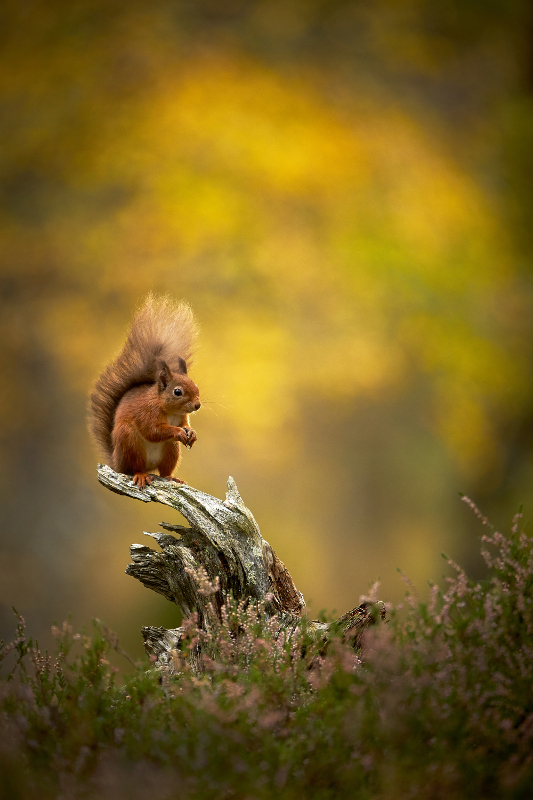
Backgrounds and foregrounds
The appearance of backgrounds and foregrounds can make or break the impact of an image. It’s something that personally I take great care in trying to get right.
I’m always checking the backgrounds whenever I start a shoot, taking some test shots (without the subject most of the time), checking the camera data and compositions. I will reposition myself if I’m not happy with the background, check the camera data again, and just wait for the squirrel to run through my composition. If I can get some foreground blur or ‘mush’ in the composition too, then I’m very happy. Taking time and care over the backgrounds and foregrounds is a reliable approach.
Autumn, of course, is all about the colour – hues of yellow, red and orange which really suit the rich, red pelage of the squirrel. So positioning yourself with these splendid colours as a backdrop really adds seasonality to the image. There’s nothing better than photographing a red squirrel amid the colours of mellow fruitfulness.
Most squirrel photography takes place in a woodland setting, which by its nature can reduce light levels. Speed is therefore of the essence; by shooting with a wide aperture, not only can you use faster shutter speeds to capture a fast-moving squirrel, the backgrounds and foregrounds will have a nice bokeh or blur too.
Natural light
Working with natural light is a key component of nature photography. The autumn months provide some great opportunities for low-level natural lighting, allowing your creativity to flourish.
Backlighting is a technique that I like to use if the weather conditions are right. Dialling in an exposure compensation between -1EV to -3EV allows you to create different creative effects, from a rim light around the squirrel to a silhouette. Just like it’s important to position yourself for good backgrounds and foregrounds, you also need to position yourself well for this technique too, with low light directly behind where you think your subject will go. Then you wait for the squirrel to run into the composition. It’s as simple as that!
With any backlighting technique, the profile of the subject is important and should show a recognisable feature of that particular animal; it does sound obvious but a silhouetted squirrel should look like a squirrel.
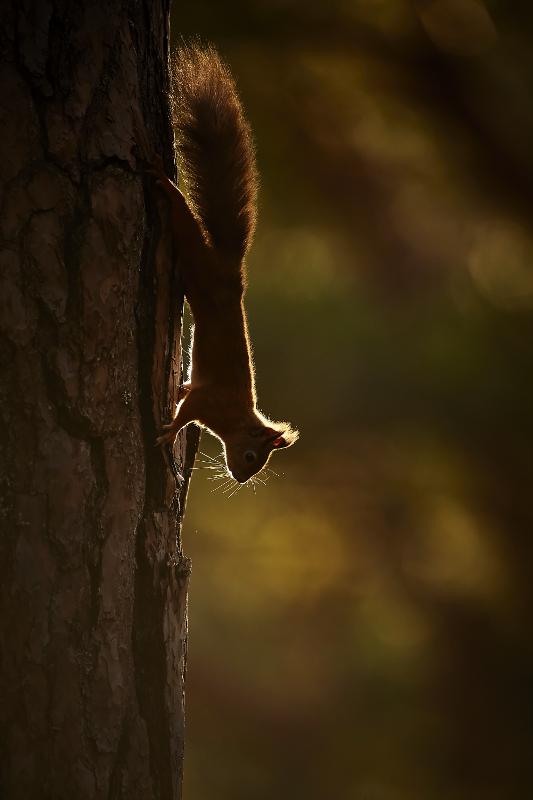
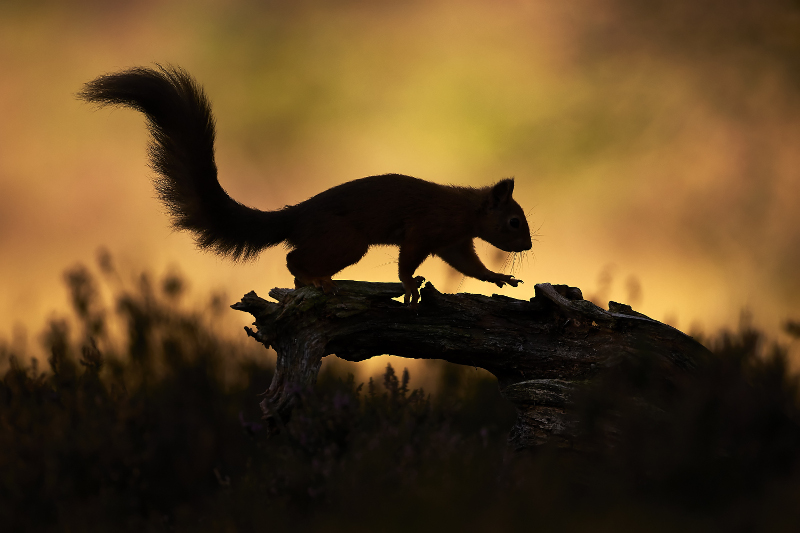
Sometimes you can also get lucky in nature photography. In the below example, the setting sun hit the autumnal leaves in the background, creating a magical moment, perhaps only three minutes in duration, where the leaves looked like out-of-focus fireworks. A combination of a well-chosen background, optimal weather conditions, natural low light and – of course – an obliging squirrel helped to create something quite special.
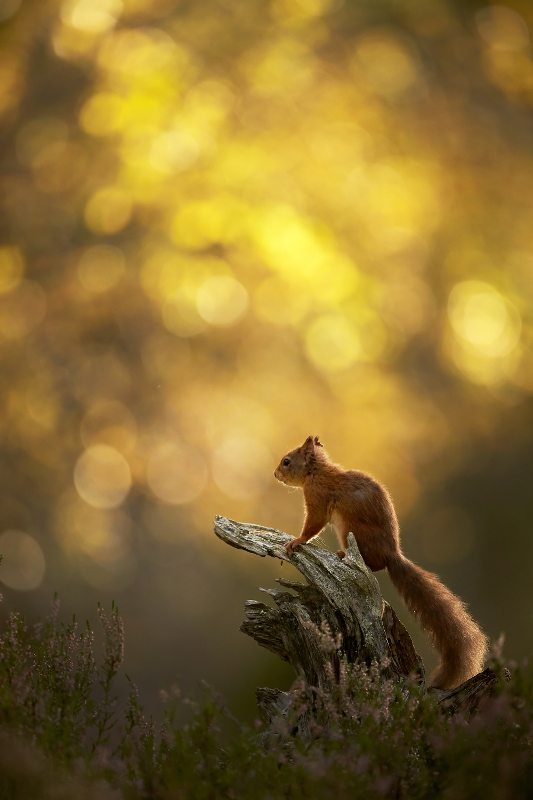
Different lenses
We use telephoto lenses in nature photography for a reason: so that we can keep a respectful distance from our wildlife subjects while also seeing the details of the animal. I generally have the same approach to everything that I photograph – using the longest lens I have to get those portrait images, while also carrying a mid-range telephoto and wide-angle so that I can pull back and include the habitat as part of the composition.
During the autumn months, the habitat can be very much part of the show with its glorious hues. Pulling back from the squirrel really helps to show an impression of the woodland, and provides a different type of image in the same location.
Red squirrels are superb little creatures. Not only are they great to photograph, but they make you smile too. What could be a better combination than that?
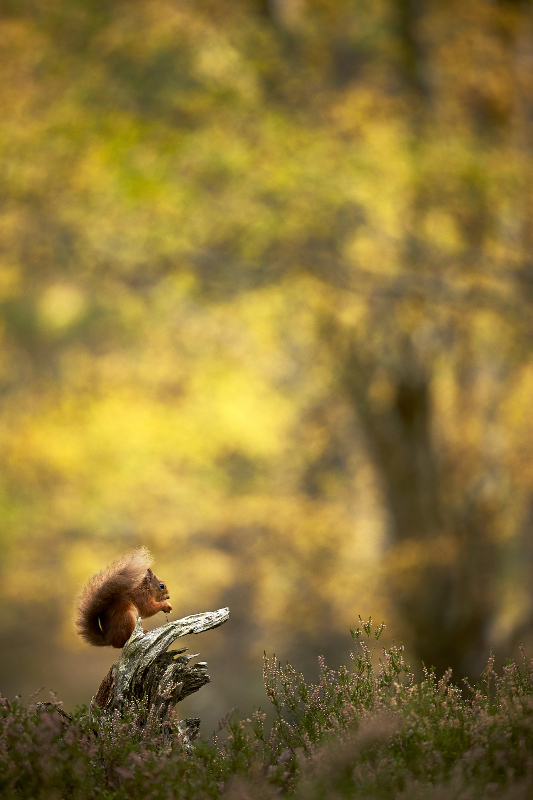
Tips
- Get to know your subject, watch behaviours. It’s cliché but it will really help you to pre-empt the shots.
- Take care with your backgrounds and foregrounds, make best use of the autumn colours and change your aspect.
- Look at the squirrel’s habitat in terms of shapes, forms, textures and colours.
- Experiment with natural light direction; backlighting works very well at this time of year when the weather conditions are right.
- Use a combination of lenses so that you can achieve detailed portrait images as well as habitat shots.
About the Author
Ellie Rothnie is an award-winning freelance wildlife photographer, tour leader and photographic guide based in the UK. Visit her Instagram, Twitter and website to see more of Ellie’s work.
Related articles
Photograph wildlife on your doorstep | The local patch and why you need one
Focusing on one species | Improve your wildlife photography
Negative space in wildlife photography | How to create dramatic images

